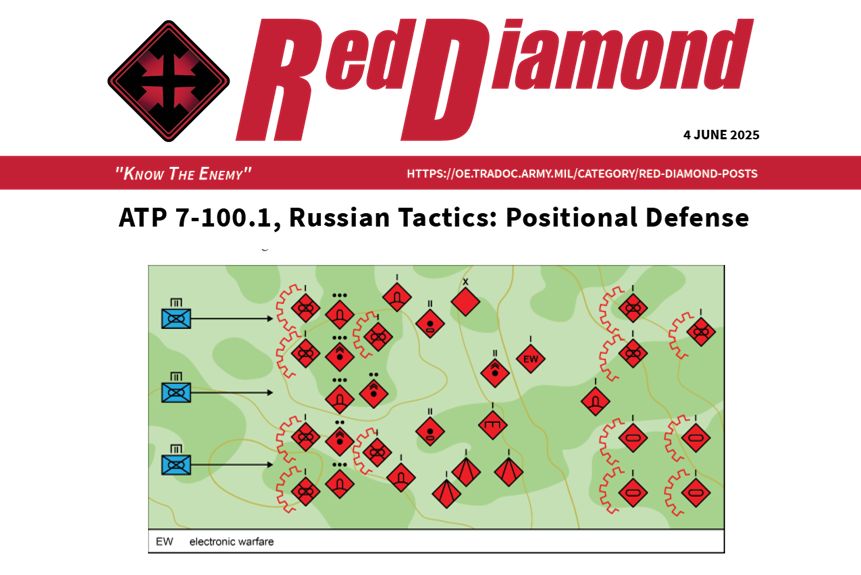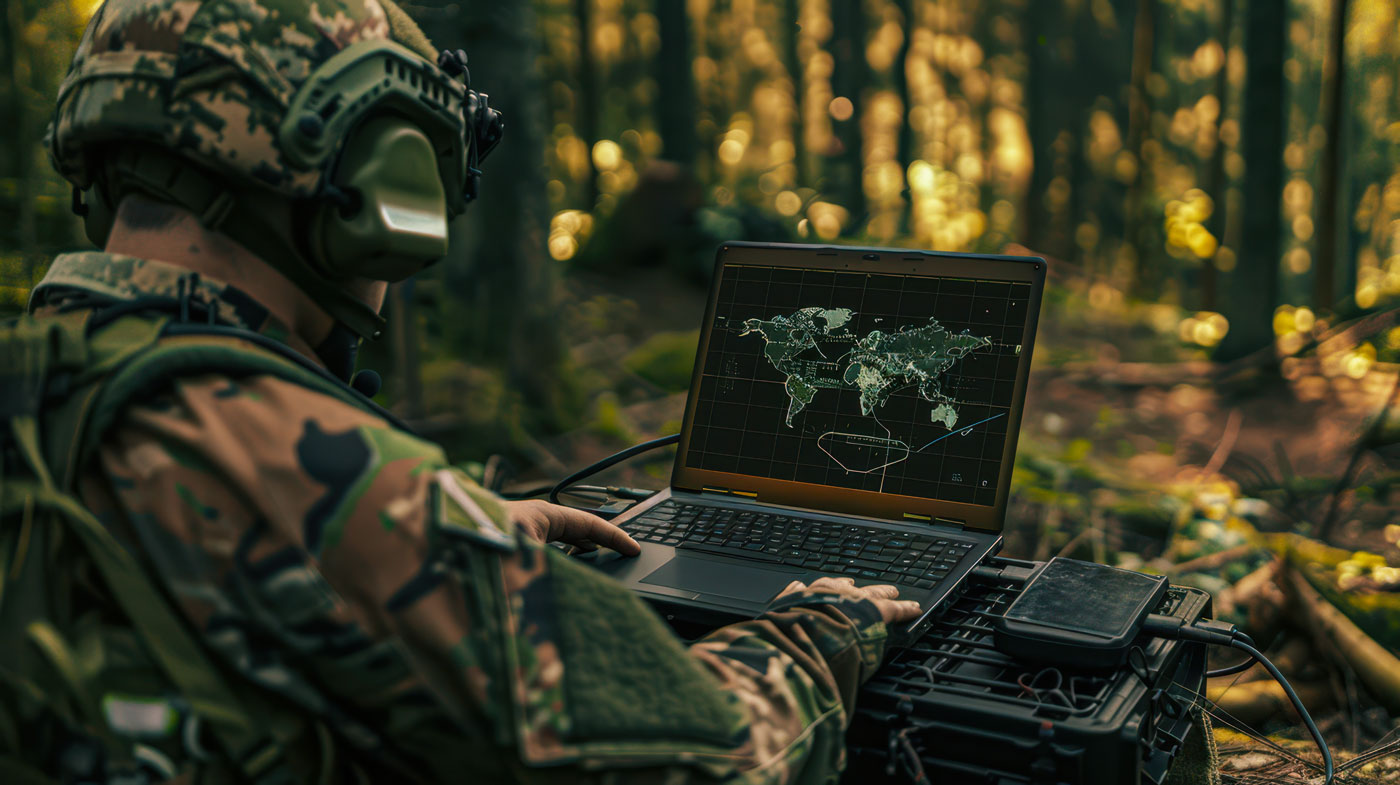
ATP 7-100.1, Russian Tactics: Positional Defense
By TRADOC G2
This article is an excerpt from the February 2024 Army Techniques Publication (ATP) 7-100.1, Russian
Tactics, and is part of a series of articles that distill critical concepts from the doctrinal publication into shorter,
more digestible pieces. ATP 7-100.1 Russian Tactics is the U.S. Army doctrinal presentation of how Russian
ground force doctrine indicates Russian ground forces will approach conflict. This article will examine how
Russian doctrine describes the defense and will explore the doctrinal application of the positional defense.
The material is drawn from Chapter 6: Defense and Appendix B: Ground Forces Maneuver of ATP 7-100.1.1
The Russian Ground Forces are not the ground force of World War II or the Cold War, which involved massive armies and millions of soldiers in a linear, cohesive, side-by-side defense. Indeed, contemporary Russian military writers suggest that the future conventional battlefield under nuclear-threatened conditions and precision weapons will be fragmented. The Russian Ground Forces will fight with open flanks protected by fires, counterattacks, strong points, difficult terrain, and obstacles. Battles in the security zone combined with maneuver defense will be common leading to a positional defense where the greatly weakened and disorganized aggressor will crash into a toughened and prepared defense.
Requirements for the Defense. According to tactical regulations, the defense must be both stable and active. Numerous Russian military academics deem stability and activeness as primary prerequisites for an effective defense. The defense must be able to defeat large aggressor attacks and protect key areas. The defense must also be able to annihilate any aggressor breakthrough of defensive positions. Notably, Russian forces can assume the defense in or out of contact with the aggressor. Russian defensive doctrine states that to achieve these requirements, the defense must include echeloned positions capable of defending against weapons of mass destruction, precision-guided munitions, and electromagnetic warfare; antitank resources; air defense resources; and antiair assault capabilities.
Elements of an Active Defense. An active defense must be capable of placing the aggressor under planned and integrated fires, and, as a rule, create adverse conditions for the aggressor to manage the battle. The active defense is achieved by thorough organization and adroit implementation of the means of nuclear and conventional fires to annihilate the aggressor. A key attribute of the active defense is the ability to conduct decisive counterattacks. Active defense measures include extensive maneuver of systems and forces in the conduct of integrated fires, assaults, and obstacles against a threatened axis of advance. The active defense also includes countering aggressor command-and-control systems, weapons, fixed-wing, rotary-wing, and unmanned aircraft systems.
Positional Defense. The positional defense is designed to exact the utmost losses on the aggressor by tenaciously holding prepared defensive positions. The positional defense is used to defend critical terrain and significant objectives considered too important to lose to the aggressor. A positional defense will be significantly echeloned by a system of defensive positions, lines, and areas and a prepared system of planned and integrated fires designed to defeat the aggressor. Russian units may also adopt a brief positional defense, typically a nonfortified firing line. This temporary defense could be employed during a meeting battle or while moving within a defensive combat formation. Typically, the temporary positional defense is used to fend off aggressor counterattacks, hold key terrain, or protect exposed flanks before shifting to offensive operations. Russian manuals stipulate that a brigade’s main defensive zone in a positional defense will be up to 15-km wide and up to 20-km deep. As always, though, the width and depth will be situationally dependent.

When the defending force is not in direct contact with the aggressor, a security zone can be formed forward of the defense out to the range of supporting fires. There can be multiple positions established within the security zone. These positions are typically spaced as to not be able to be decisively engaged by the same aggressor force, typically 6-8 kilometers from each other. Individual company and platoon strong points will also be created to hold critical areas. These strong points will be strengthened with engineering obstacles.
When no forward security zone is established, a motorized rifle or tank brigade can form a forward position 6-8 kilometers from the forward edge of the defense. This position is designed to mislead the aggressor as to the actual location of the forward edge of the defense, repel hasty offensive actions on first echelon subunits, and cause the aggressor to precipitately deploy its main combat elements. Reinforced companies will be obtained from first echelon motorized rifle battalions to shield the forward positions by establishing company and platoon strong points.
A combat security zone will usually be formed, up to 2 kilometers from the forward edge of the defense. It is typically formed to defend approaches not covered by forward positions, and where there is no contact with the aggressor. The combat security zone is designed to prevent surprise attack and thwart aggressor ground reconnaissance of the first echelon battalions. If there is no direct aggressor contact, the mission of the combat security zone may be performed by subunits from the first positions of the first trench.
The main defensive position consists of combined company strong points integrated in the battalion defense area. The depth of the battalion defensive position can be up to 3 kilometers and will be established within a trench system when time allows. The first trench is in the first defensive position on the forward edge of the defense. The brigade commander will determine the outline of this position, while the battalion commander will determine the exact location. The first trench will be defended by platoons from the first echelon. Mines are typically placed in front of the first trench.
The second trench is normally established 400-600 meters behind the first trench. Subunits located in the first trench will be covered by fire from the second trench. Subunits in the second trench will also cover the approaches to the forward edge of the defense and any obstacles laid out in its front.
The third trench is typically built 600-1000 meters behind the second trench and placed to allow its subunits to provide direct fire on the zone between the second and third trench, on separate sections and in front of the forward edge of the defense. The third trench may also be used as a start point for maneuver against vulnerable areas in the event of an aggressor counterattack.
The fourth trench is established 600-1000 meters behind the third trench. Subunits in the third trench will be covered by fires from the fourth trench. The fourth trench will also cover the approaches to the forward edge of the defense and any obstacles laid out in its front.
Russian military doctrine has acknowledged that the defense is stronger than the offense and believes that successful defensive operations will set the conditions for follow-on decisive offensive actions once the enemy is exhausted.2 Observations of the Russian Ground Forces’ positional defense during the so-called “Special Military Operation” in Ukraine highlight their dependence on fires, mines, and obstacles to strengthen Russian defensive positions.3 Russian commanders have used defense in depth and Ukrainian speed and violence of action to draw the attacking force into a kill zone before launching a rapid counterattack.
Notes
- ATP 7-100.1 Russian Tactics. (2024) 2024. C.1 ed. Fort Leavenworth, KS: United States Army. https://armypubs.army.mil/
epubs/DR_pubs/DR_a/ARN40737-ATP_7-100.1-001-WEB-4.pdf - Grau, Lester W, and Charles K Bartles. 2018. The Russian Way of War. Foreign Military Studies Office.
- Axe, David. “To slow the Ukrainian counteroffensive, the Russian army quadrupled the size of its minefields.” Forbes.
September 5, 2023. https://www.forbes.com/sites/davidaxe/2023/09/05/to-slow-the-ukrainian-counteroffensive-the-russian
army-quadrupled-the-size-of-its-minefields/?sh=3f59f52469e.
Distribution A: Approved for public release
Categories:
Tags:
ATP 7-100.1, Russian Tactics: Positional Defense
By TRADOC G2
File Size:
362KB
File Type:
Page Count:
4


